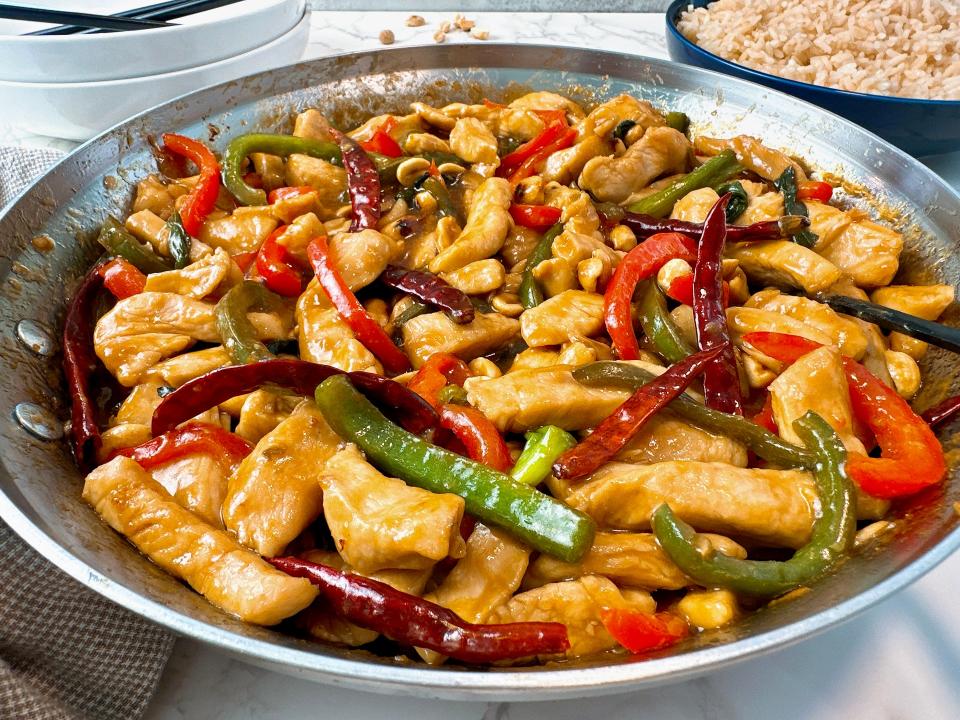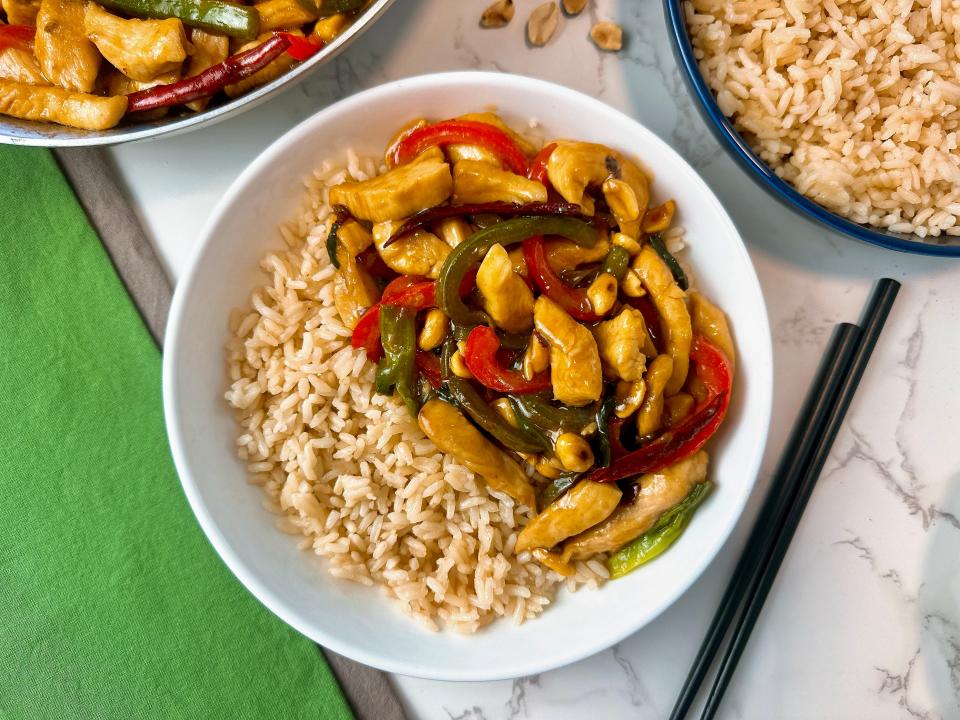Making kung pao chicken is faster than ordering takeout. Here's your new go-to recipe
One of the most popular items on a Chinese takeout menu, kung pao chicken features golden-brown, stir-fried chicken, crunchy nuts and a slick of sweet and savory chili sauce. The moderately fiery dish is loved by adults and kids alike and making it at home is as easy as — and even faster — than, ordering takeout.
What makes this dish so quick to cook is the stir-frying method. The key here is chopping your chicken and veggies and whisking up the sauce before firing up your wok or frying pan, as the cooking itself takes mere minutes. But even with all the chopping, you can enjoy a lightened-up version of this takeout staple in around 30 minutes with only a handful of ingredients, making it a perfect weeknight meal.
What is kung pao chicken?
Kung pao chicken is a classic, spicy chicken stir-fry from the Sichuan province of southwest China. Recipes vary, but the core ingredients remain the same: chicken, chile peppers and a garlicky sauce made with soy sauce, vinegar, rice wine and sugar. While Chinese restaurants often use specialty ingredients, such as Szechuan peppercorns, Chinese black vinegar and Chinese rice wine, you can achieve a similar spicy, sweet, tangy and umami flavor with ingredients you likely already have in the pantry or can easily find at any supermarket.

What chicken should you use in a stir-fry?
Choose chicken breasts, tenders or thighs. This is a personal preference, but note that chicken thighs will retain more moisture. When using chicken breasts and tenders, be careful not to overcook them or the meat will dry out. I used boneless, skinless chicken breasts.
Note: You can cut your chicken into strips or cubes, there are no rules when it comes to the shape of the pieces. While chicken shape doesn’t matter, making the pieces a consistent size does, so make sure to cut the chicken into equally sized pieces so they cook uniformly.
Now open: Nobuo Fukuda has a new restaurant in Scottsdale
Substitutions for Szechuan peppercorns
Use dried chiles or, in a pinch, red chili flakes. Dried chiles are what make kung pao chicken unique because they introduce the iconic Sichuan flavor known as Mala/麻辣 or numbing and hot. Dried chiles are smoky, fiery and critical to the success of this dish. That said, you don’t have to choose the spiciest chiles on the market. Choose a variety that’s readily available and a heat level that suits your taste.
I used chile de arbol, which are easy-to-find dried chiles that are hotter than serranos yet milder than habaneros. It’s a nice middle ground. And, you can add as many as you want, which means you control the heat. This recipe calls for eight to 10 chiles, but you can add just two if that’s your preference. Note, the chiles are meant to flavor the dish, they’re not meant to be consumed.
Pro tip: Choose fresh-looking dried chiles, meaning those that are vibrant and shiny; they will soften slightly and lend great flavor when introduced to the sauce.

What nuts should you use for kung pao chicken?
Toasted or deep-fried peanuts are the classic choice for kung pao, but you can also use cashews. Nuts balance the dish by adding taste and texture while complementing the sweet, spicy, tangy elements of the other ingredients.
Pro tip: Toast the nuts before adding them to the dish and add them to the pan of kung pao at the end of cooking, as instructed below, to guarantee a more flavorful, nutty crunch.
Try them all: 100 essential restaurants in metro Phoenix
Recipe: Kung pao chicken
Makes: 4 servings
Ingredients:
¼ cup plus 2 tablespoons soy sauce, divided
2 tablespoons cornstarch, divided
1 ½ pounds boneless, skinless chicken breasts, tenders or thighs, cut into bite-size pieces or thin strips
1 tablespoon rice vinegar
1 tablespoon Shaoxing rice wine or mirin (Japanese rice wine)
1 tablespoon granulated sugar
2 teaspoons toasted sesame oil
¼ teaspoon ground ginger
⅓ cup roasted, unsalted peanuts or cashews
2 tablespoons vegetable oil
1 red bell pepper, seeded and diced or cut into thin strips
1 green bell pepper, seeded and diced or cut into thin strips
8-10 dried red chiles or 1 teaspoon red chili flakes, more or less to taste
5-6 green onions/scallions, white and green parts, cut into 2-inch pieces
3 cloves garlic, minced
Salt to taste
Cooked jasmine rice for serving
Instructions:
In a medium bowl, whisk together 2 tablespoons of the soy sauce and 1 tablespoon of the cornstarch. Add the chicken and toss to coat. Let the chicken marinate for 15 minutes.
Meanwhile, in a small bowl, whisk together the remaining soy sauce, remaining tablespoon of cornstarch, rice vinegar, rice wine, sugar, sesame oil and ginger. Set aside.
Toast the peanuts in a large, dry skillet over medium heat shaking the pan frequently. Stay close to prevent burning. You want the nuts lightly toasted and aromatic. Set aside to cool.
Heat 1 tablespoon of the vegetable oil in a large skillet or wok over medium-high heat. Add the chicken to the hot oil and cook until golden brown on all sides, stirring frequently. If necessary, work in batches to prevent crowding the pan. Transfer the chicken to a plate.
Heat the remaining tablespoon of vegetable oil in the same skillet over medium heat. Add the bell peppers and cook for 3 to 5 minutes or until the peppers soften. Add the dried chile peppers (or red chili flakes), green onions and garlic and cook for 2 to 3 minutes, until fragrant.
Return the chicken to the pan with any accumulated juices from the plate. Whisk the sauce to make sure the cornstarch is dissolved (it sometimes sticks to the bottom of the bowl when sitting) and add the sauce to the pan. Bring to a simmer, reduce the heat to medium-low and cook for 2 to 3 minutes or until the sauce thickens and the chicken is cooked through.
Fold in the peanuts and season to taste with salt.
Remove from heat and serve with Jasmine rice.
Questions or comments? Email the culinary team at cooking@azcentral.com.
This article originally appeared on Arizona Republic: Kung pao chicken is a fast, easy weeknight dinner that packs a punch

